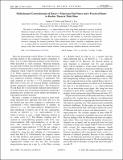Multichannel Generalization of Kitaev’s Majorana End States and a Practical Route to Realize Them in Thin Films
Author(s)
Potter, Andrew Cole; Lee, Patrick A.
DownloadLee.pdf (736.5Kb)
PUBLISHER_POLICY
Publisher Policy
Article is made available in accordance with the publisher's policy and may be subject to US copyright law. Please refer to the publisher's site for terms of use.
Terms of use
Metadata
Show full item recordAbstract
The ends of one-dimensional p+ip superconductors have long been predicted to possess localized Majorana fermion modes [A. Kitaev, arXiv:cond-mat/0010440]. We show that Majorana end states are robust beyond the strict 1D single-channel limit, so long as the sample width is not much larger than the superconducting coherence length, and they exist when an odd number of transverse quantization channels are occupied. Consequently, the system undergoes a sequence of topological phase transitions driven by changing the chemical potential. These observations make it feasible to implement quasi-1D p+ip superconductors in metallic thin-film microstructures, which offer 3–4 orders of magnitude larger energy scales than semiconductor-based schemes. Some promising candidate materials are described.
Date issued
2010-11Department
Massachusetts Institute of Technology. Department of PhysicsJournal
Physical Review Letters
Publisher
American Physical Society
Citation
Potter, Andrew C., and Patrick A. Lee. “Multichannel Generalization of Kitaev's Majorana End States and a Practical Route to Realize Them in Thin Films.” Physical Review Letters 105.22 (2010): 227003. © 2010 The American Physical Society.
Version: Final published version
ISSN
0031-9007